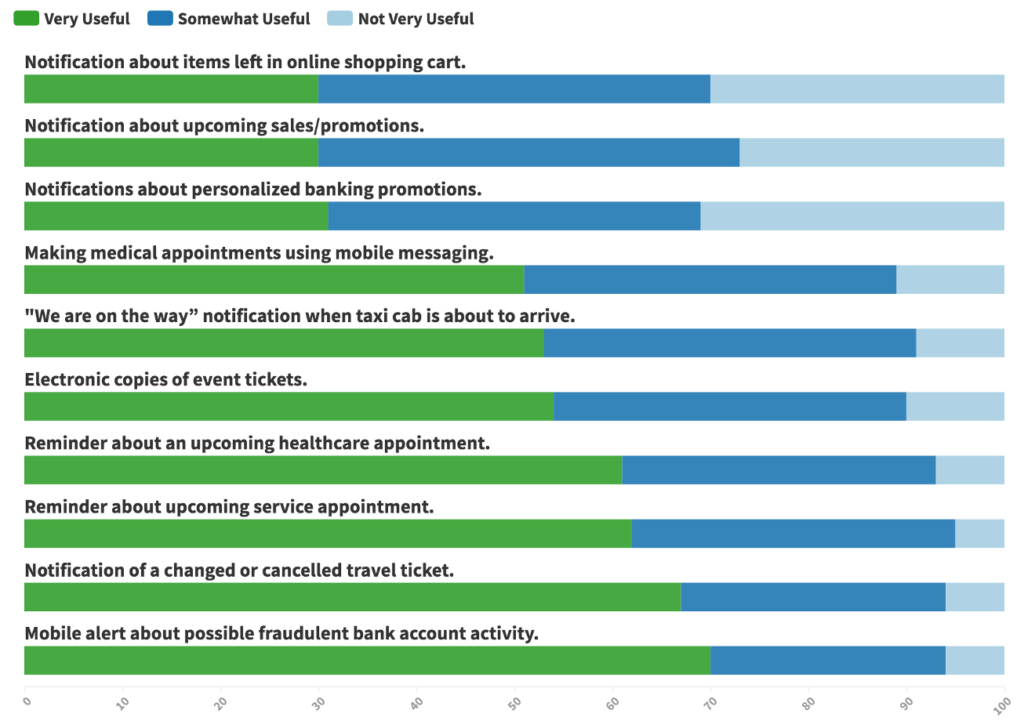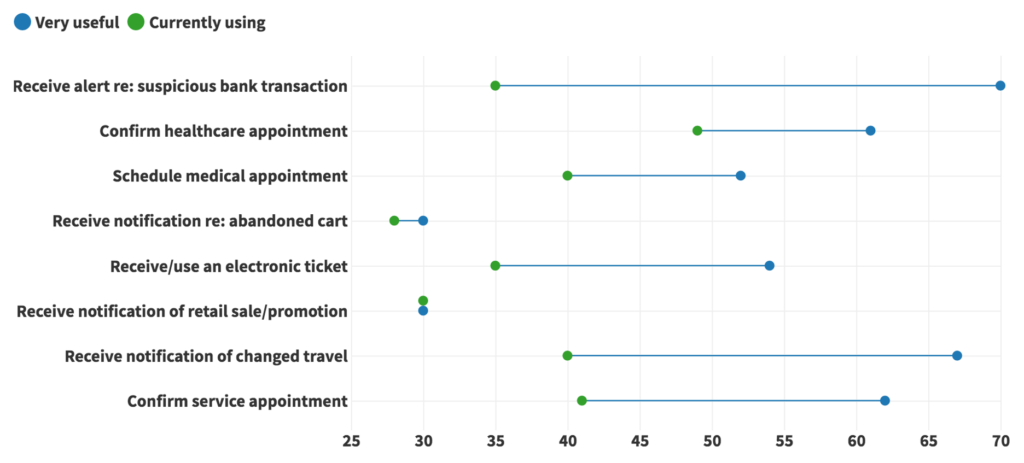Insights, Products
9 ways mobile marketing can help reduce consumer friction

Insights, Products

CMOs and CRMs are constantly evaluating how best to connect with their consumer/customer base. Which digital and mobile experiences will best drive business objectives? And how to get their audience to “opt in” and remain loyal?
Too many enterprise companies are stuck in a digital rut–relying on existing strategies and channels, and failing to experiment with newer ideas and delivery systems. One big opportunity gap is mobile messaging. Recent research from Sinch shows consumers are enthusiastic about receiving messages from businesses, as long as those messages have value. (See chart below.)

What’s more, consumers Sinch surveyed consistently reported a higher demand for messaging-based interactivity than they use today. (For example, 35% currently receive mobile messages from their bank reporting potential fraud in their account, yet 70% would find it “very useful.” This type of opportunity gap was found across more than one industry.)
Consider also that messaging has higher open rates than other tried-and-true channels, such as email. Two in five consumers say they have at least 50 unread emails in their inboxes, but just 4% say they have 50 or more unread mobile messages (Sinch). And time spent on messaging apps is on the rise. Research from eMarketer shows time spent on mobile messaging apps increased 20% from 2017 to 2019.
While messaging is a powerful opportunity for marketers and CX leaders to reach their audiences, the key is personalizing the message. This means understanding–at the individual level–the channels your customers prefer, and what types of messages they respond to and find valuable. Pierluigi Bosco, Senior CRM Channel Manager at Shell, explains: “With all the data available about consumers’ online and transactional behavior, marketers tend to cluster customers into segments. The reality is that everyone is different and customers expect to be treated as unique. The challenge and the beauty of today’s marketing and CRM is to make sure we treat every customer individually rather than as part of a bucket of people. We need to create experiences, communications and offers based on individuals.”
Let’s review some of these new opportunities–and in particular, the ways companies are making it easier for customers to sign-up, opt-in and join loyalty programs by using mobile messaging.
When customers sign up for content updates and promotions, you need a way to verify their opt-in status and ensure that regulatory guidelines are followed. Messaging provides an easy, intuitive way to speed the process and document compliance. What’s more, most messaging providers offer a range of security measures for consumers–from vendor number verification spam detection, to two-factor authentication to protect login credentials.
Retailers, restaurants, and a wide range of service companies can offer in-crowd promotions via texting. These can be time-limited offers, low stock alerts, invites to store events, among many others. Customers can receive promotions on a regular cycle (push messaging) or request the latest deals (pull messaging).
Tell your customers their order is on the way. Currently most of these types of notifications are sent using simple text (SMS/TXT), but with the growing availability of RCS and rich messaging, businesses will be able to send interactive notifications. For example, let your customers pinpoint the exact location of the delivery truck on the map. And use response chips to address customers’ most common questions and requests, such as rerouting delivery to another location. (For much more about messaging using RCS, see our recent blog post on the topic.)
If you’re hosting an event–whether consumer focused or a professional conference–use messaging to deliver time-sensitive information, venue guides and FAQs, safety advisories, giveaways or contests, and attendee surveys. Plus messaging is a great way to upsell additional products and services available for purchase.
For businesses with cycles of high-traffic versus low traffic (e.g. dining and entertainment venues), consider sending late-breaking discounts via messaging to fill low-traffic periods. “Get 20% off your dinner tonight if you arrive before 6pm!”
Best-in-class customer experience means being available to your audience at the place and time they prefer. Using messaging, businesses can reduce wait times and increase satisfaction. For example, answer easy questions using automated response chips (available through RCS or rich messaging), which then frees up your customer service agents to address more complex issues. And with the rise of social retail (e.g. Instagram Shopping), in-app messaging lets you meet your customer at the very moment they need support.
Make it easy for customers to sign up for appointments by text. Chatbot-enabled messaging makes it easy for customers to pick a day and time, confirm upcoming appointments and add them to their mobile calendars. No more waiting on the phone to speak to a human.
Sometimes customers want to know exactly what they are being charged for. Consider creating a personalized video for each of your customers that explains exactly the service you’re providing. For example, Direct Tire & Auto in the United States sends customers a short mechanic-narrated video that shows exactly which repairs were completed as he/she tours your car’s exterior in the shop.
Messaging doesn’t always have to be utilitarian. Consider using TXT/SMS to deliver entertaining content as well, such as quizzes or links to guides/articles. Starbucks, for example, kicked off a summer campaign asking customers to message WOOHOO to a short code, and receive fun GIFs in return.
While offering coupons and promotions is one of the easiest messaging campaigns to get underway, businesses should use the tactic with moderation. As part of its Mobile Consumer Engagement 2020 study, Sinch asked consumers what types of business interactions they had with businesses via messaging, and which they would find useful. (See chart below.) The gap between “using” versus “useful” was largest for those activities that were less promotional and more practical.

Also, when using “text-to-join” promotions, be sure your confirmation message is transparent about the maximum number of messages the user will receive in a given month, and give clear instructions about how to opt-out in the future. Messaging is a deeply personal channel–you’re reaching your customers on a device that is “always on.” Be sure deliver messages that are welcome and useful, or you run the risk your customers will quickly opt out.
Want to find out even more about next-generation messaging and consumers attitudes about new mobile channels? Read the Mobile Consumer Engagement 2020 report here.